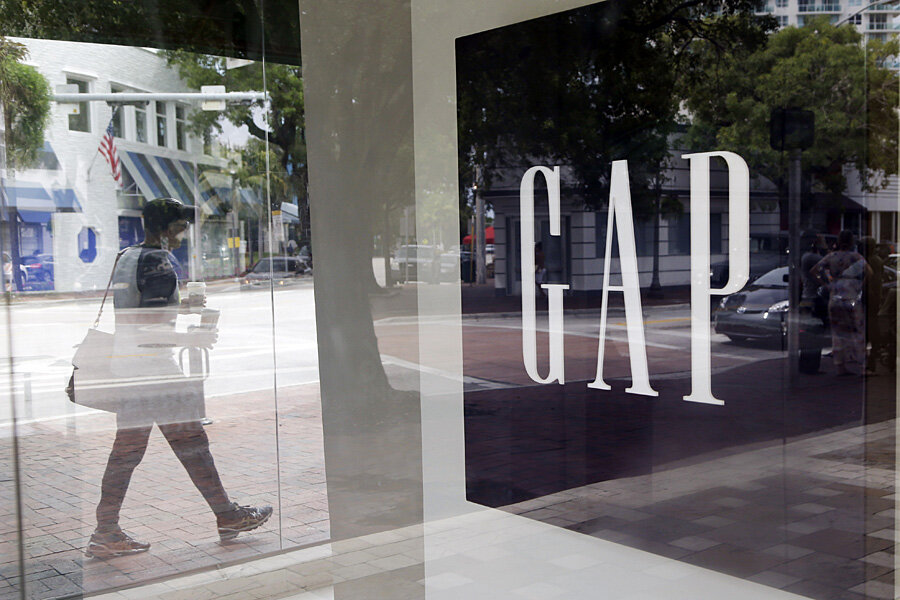Gap: Can icon of American casual wear survive fast-fashion universe?
Loading...
Gap, the iconic retail brand known for casual, American style, is facing another quarter of slumping sales after months of decline.
The company reported Tuesday that sales in the first quarter of this year fell 6 percent from the same time last year, coming in at $3.44 billion, lower than the $3.54 billion that was forecast.
The declines, not only at Gap, but also at Banana Republic and Old Navy, which are both owned by Gap Inc., are leading the half-century-old retailer to reconsider the number of stores it operates overseas in an effort to "sharpen its focus on geographies with the greatest potential," according to a company statement.
Gap will provide more details when it reports first quarter results on May 19, but Fortune writes that the company has identified China as a promising market, suggesting it might close some stores in Europe and the rest of Asia. The company had 3,721 stores around the globe as of January 30, according to The Wall Street Journal, including 480 Gap-branded stores outside North America. There were 61 Banana Republic and 65 Old Navy locations outside North America, with a majority of those in Japan.
"We are committed to better positioning the business to recapture market share in North America and to capitalizing on strategic international regions where there is a strong runway for growth," Art Peck, chief executive officer of Gap Inc., said in a Monday statement.
Despite bringing in Mr. Peck last year, and overhauling the designs for spring merchandise, the company that's emblematic of malls that put Main Street out of business in the 1960s has been unable to compete with today's fast-fashion retail trends. Nor have stores such as The Sports Authority, Pacific Sunwear, and Aeropostale, all of which have filed for bankruptcy this year. Sears and Macy's have each closed dozens of stores in 2016.
Fast-fashion brands such as H&M and Zara owe their success to their ability to respond to the latest trends, which they offer quickly and cheaply.
"The faster you are in conceiving product and putting it on the shelf, the less risk there is," Peck told Fast Company.
It takes Gap three times as long as brands such as H&M and Zara to get new product ideas into stores – 10 months, minimum. Peck told Fast Company last year that he was working with the company's vendors to cut production time down to around 7.5 months.
Some industry observers say that Gap needs to close more stores to save its business in an era of online shopping and thrifty consumers. Sales at Gap’s North American stores have been suffering for a decade, according to Fast Company.
The retailer already has closed about 513 of its namesake stores in North America since 2009. By the end of 2015, it had about 866 Gap brand stores left here.
"If you really ask me what the big issue is [in retail], it's that the country is over-retailed, and that is causing the most pain," Sandeep Mathrani, chief executive of General Growth Properties, which owns 131 US malls, told The Street.
"The reason why we are over-retailed is do you really need 800 Gap stores? I mean who needs 800 stores in the country?" he asked.
In the grand scheme of retail, physical stores are still important, despite the success of Amazon.com – which even has physical stores now.
"The new vocabulary is that online needs bricks and mortar," Mr. Mathrani told The Street. "If you look at the math, about 60 percent of all venture capital money devoted to retail is being invested into opening bricks-and-mortar stores," he said.
The idea behind keeping some physical stores is that getting customers to buy products online and return them in the store is much more profitable, given that they're likely to buy more once they come into the store to make the return.
"If you talk to the bricks-and-mortar retailers that have built an omnichannel presence, the only part that is truly profitable is when you reserve online and pick it up in the store," said Mathrani.
Gap already is investing in this shift to merge the online and offline retail experiences, though its experiments haven't paid off yet. For instance, the company’s "find in store" service tells customers where to find the nearest stores, and the "reserve in store" service allows them to reserve up to five items online to try on in a store.
As Fast Company described of Peck last year:
He's testing showroom formats, mobile registers, RFID–tagged clothing, interactive digital walls, and even something that might resemble a vending machine. Peck has developers in Silicon Valley camped out at Gap, Banana Republic, and Old Navy stores, incorporating customer and salesperson feedback into code in real time. "I think that kind of rapid prototyping – typical in a lot of other industries, not so typical in ours – will be critical for figuring out this collision of physical and digital," he says.
Shares of Gap Inc. fell more than 10 percent in after-hours trading Monday to $19.50. A year ago shares traded at $39.61, according to the Associated Press.






